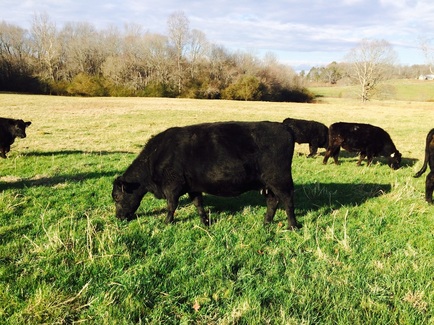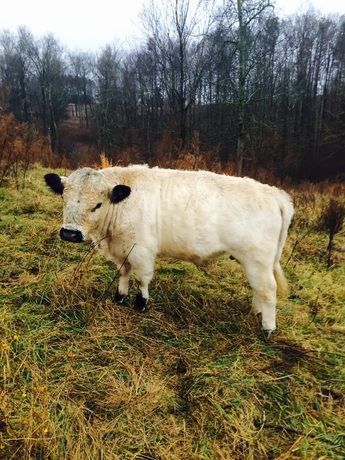
Our cattle herd consists of Angus cattle and British White cattle.
Angus cattle are native to the counties of Aberdeenshire and Angus in Scotland and are know as Aberdeen Angus. Known as Angus doddies before the 1800's the best black polled cattle were collected for the herd owned by Hugh Watson. In 1873 4 Angus bulls were brought to the US, shortly after more Angus cattle were imported from Scotland and in 1883 the American Aberdeen Angus Association was created in Illinois.
Our Angus cattle come from the genetics base of Ohlde Cattle Co. where they focused on moderate frame size, fertility, easy fleshing, excellent maternal instincts, structurally correct and bred to live on forges all the time. We bought several head from Shelby Cattle Co. in Tennessee as we started our herd. Angus cattle are well known for the marbling and tenderness as well as other carcass traits but the high humidity and heat is sometimes an issue. Bring on the British White Cattle.

British White cattle are not as well known as the Angus but the meat is as finely marbled, tender and flavorful. Some authors suggest the British White cattle were brought to the United Kingdom by the Romans about 55 B.C. Other evidence suggest the cattle were in the UK before the Romans as early as 4000 B.C. In the 17th century British Whites were kept in the Park of Whalley Abbey, a former Cistercian abbey in Whalley, Lancashire, England. In the early 19th century they were brought to Norfolk, England were they were sold mostly to nobility. In 1940 the British government ordered that a group of British White cattle be shipped to America when the UK was invaded. This was the only time it was done for a cattle breed and only the British Whites were safe guarded this way.
In earlier times British White cattle were used as a dual purpose breed producing milk and beef but now are mainly used for beef. British Whites are mostly white with black points, polled, fleshy, medium framed and compact. British Whites are hardy and thrifty cattle that do well on poor pastures but when given good pastures they do very well. The meat from British White cattle is finely marbled, tender and flavorful. As Thomas Bewick said in 1790 "The British Whites naturally have little fat or no fat within but it is interlarded with the flesh". Certain Associations have been trying to produce what the British White cattle do naturally for over 200 years.
In earlier times British White cattle were used as a dual purpose breed producing milk and beef but now are mainly used for beef. British Whites are mostly white with black points, polled, fleshy, medium framed and compact. British Whites are hardy and thrifty cattle that do well on poor pastures but when given good pastures they do very well. The meat from British White cattle is finely marbled, tender and flavorful. As Thomas Bewick said in 1790 "The British Whites naturally have little fat or no fat within but it is interlarded with the flesh". Certain Associations have been trying to produce what the British White cattle do naturally for over 200 years.
